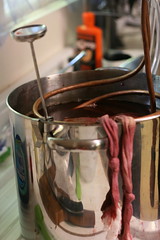How The Process Of Beermaking Is Done
Tuesday, August 25, 2009

How The Process Of Beermaking Is Done
Submitted by: Greg Hall
When you think of brewing you probably think of brewing a good cup of coffee. Brewing can also be the process of making alcoholic beverages as well. Beer is one of these beverages that brewing is used for and fermentation is used to make beer.
Brewing can be traced back to ancient Egyptian times. The fermentation process was discovered accidentally by the Sumerians. No one knows exactly how this occurred however as it was not written down. It is thought that it may have had something to do with the making of bread since many of the ingredients are the same and if left without cooking, or completely cooking the bread mixture can ferment. They were able to repeat the process and continue to create the drink, which they obviously enjoyed the first time it happened. The beer of this era could not be stored and did not have any foam. Beer was thought to contain a spirit or god because drinking the mixture seemed to possess the person who drank it.
Unlike wine where fruit juices are a big part of the ingredients, beer's major ingredients are malt and hops. Add to this yeast, sugars, and water and in the right combinations and with the right processes you will get beer. The first process to undergo is mashing. Mashing is where crushed malt and hot liquor are combined and kept at a constant temperature for about an hour so that the enzymes convert the starches into a fermentable sugar. The mash would be similar in consistency to cream of wheat or oatmeal.
Water is then filtered through the mixture to dissolve any remaining sugars. This is called sparging. The liquid that is heavy with sugar is known as wort. Boiling is now required to remove excess water, remove microorganisms, remove any sweetness, and develop bitterness. The wort is collected in containers called fermenting vessels.
The next step is fermentation; during this process yeast converts simple sugars into alcohol and carbon dioxide plus a wide range of flavors. Every yeast has its own flavor profile so this explains why each beer company has its own distinct flavor.
Packaging is the last step. At this stage the beer contains alcohol but not a lot of carbon dioxide. In order to fix this there are not a lot of options, the most common one used is forced carbonation by adding it directly to the keg or bottle. Casks for real ale, kegs for brewery carbonate beer, and cans or bottles for take away sales. During packaging you must be careful to not oxidize the beer or it will become stale. It depends on the person as to whether or not the beer is aged.
About Author: Gregg Hall is an author living in Navarre Florida. Find more about this as well as Home Beer Brewing at http://www.brewmybeer.com
Article Source: ArticlesAlley.com
Photo by: colbs
Have New Posts From Making Homemade Wine and Beer Delivered To Your Email

 Follow Me On Twitter
Follow Me On Twitter

0 comments:
Post a Comment